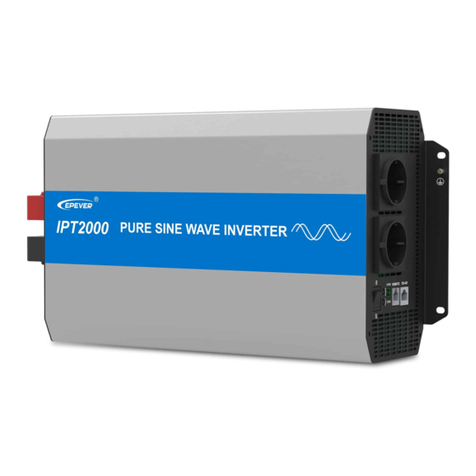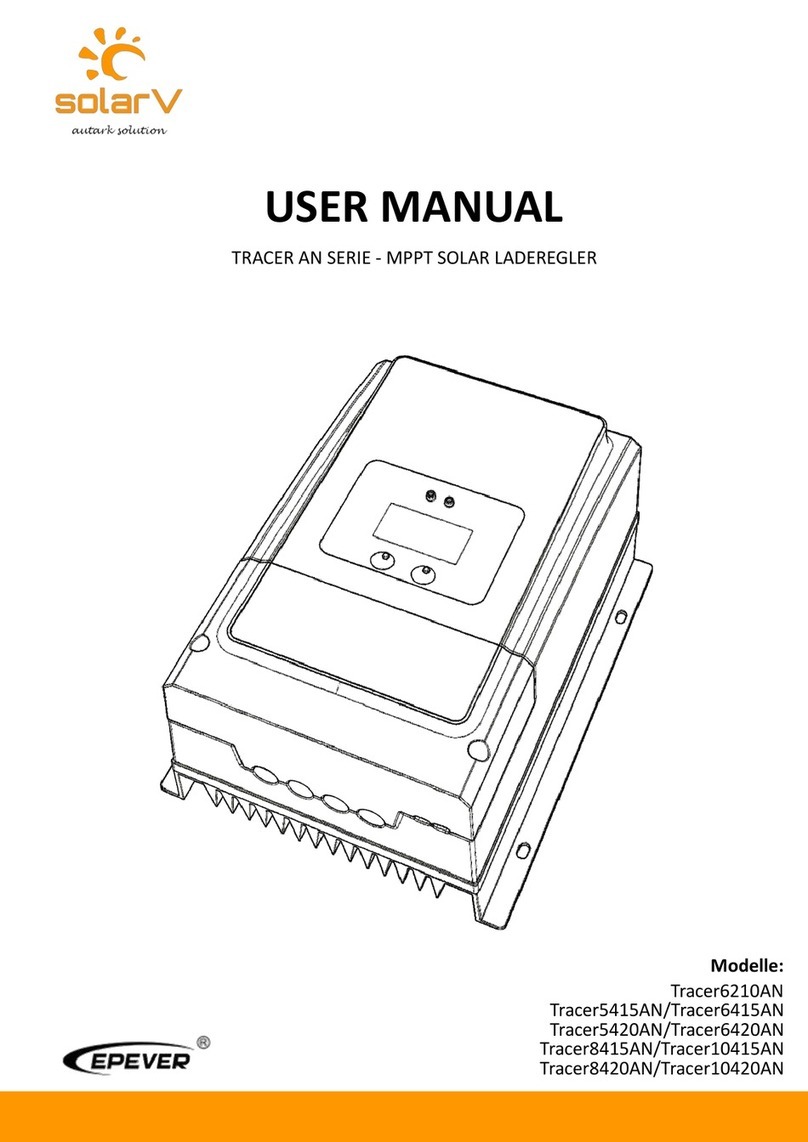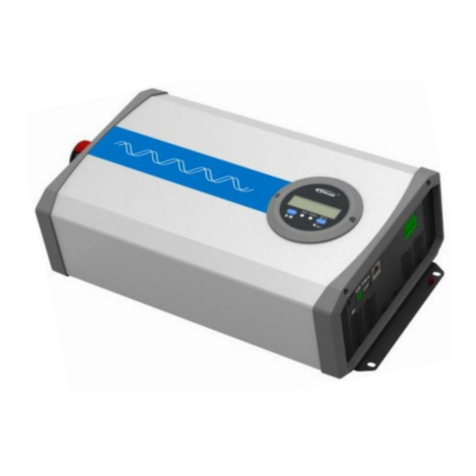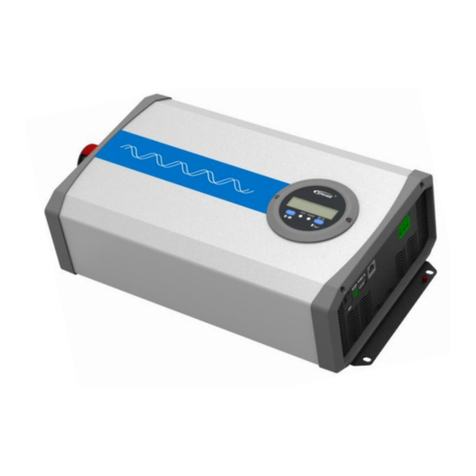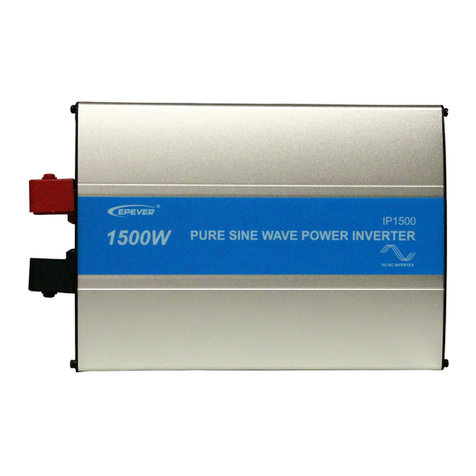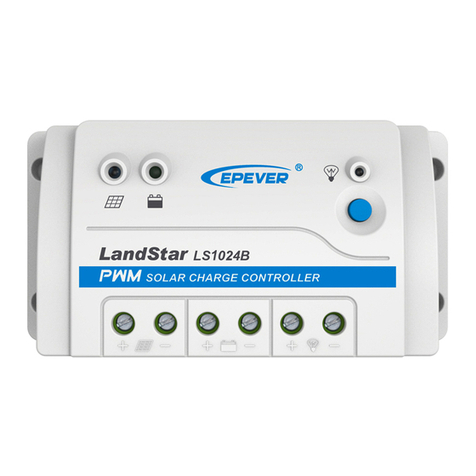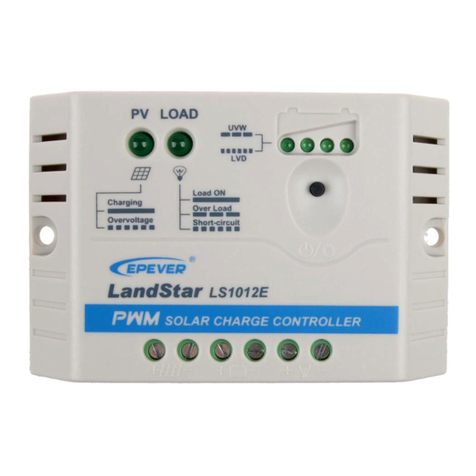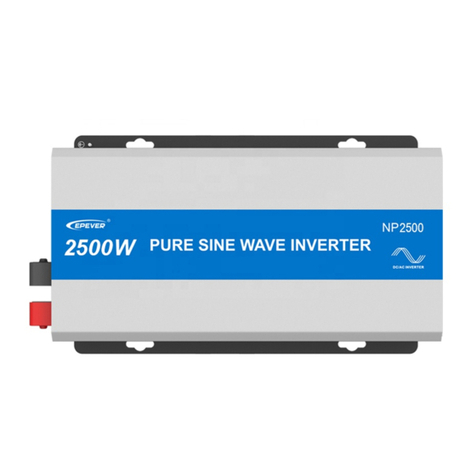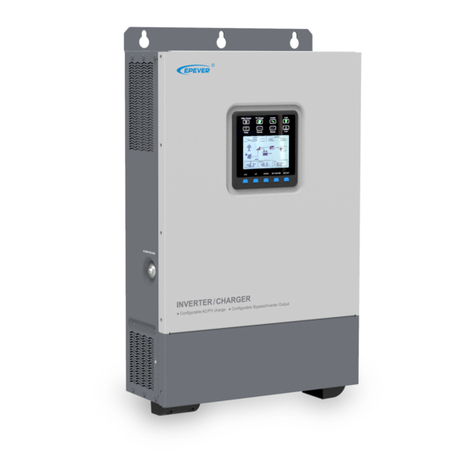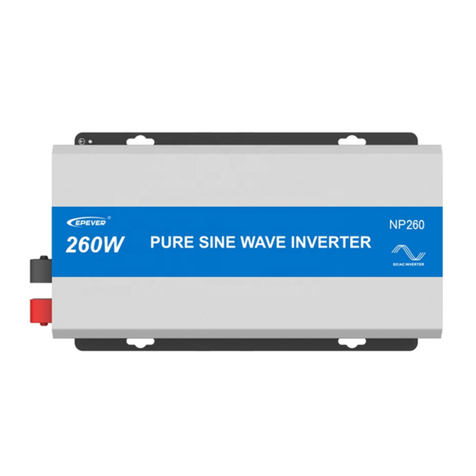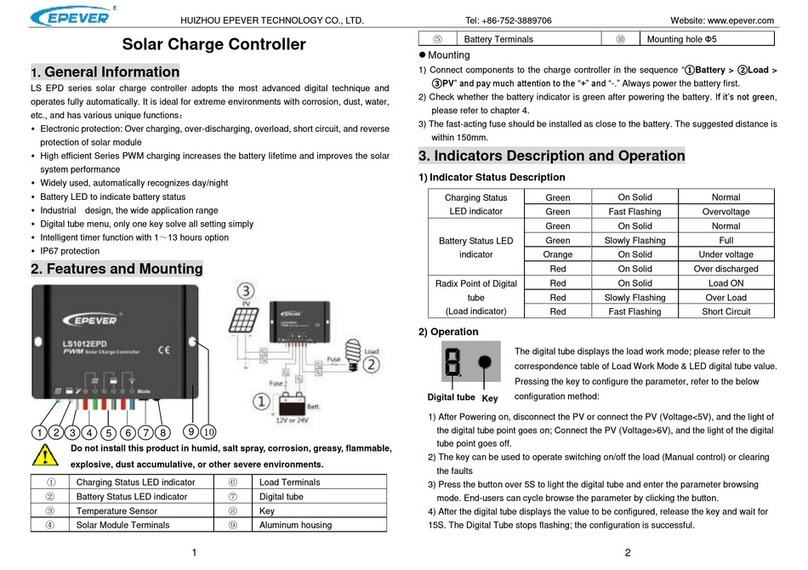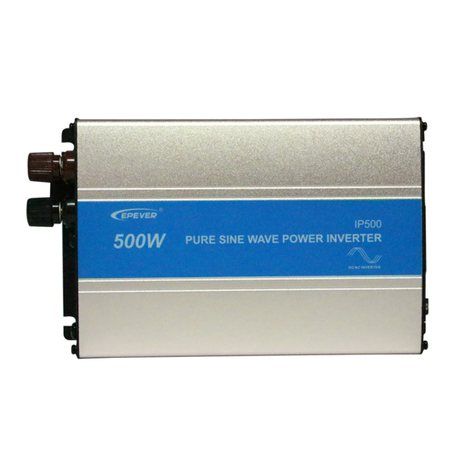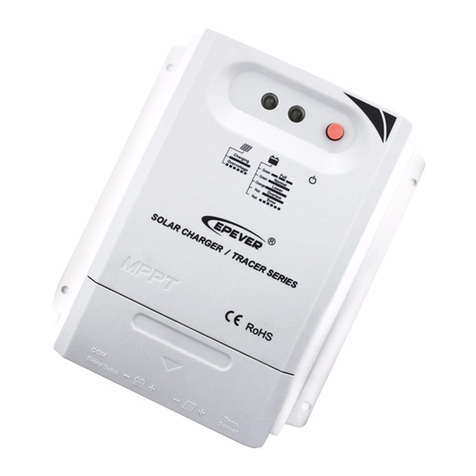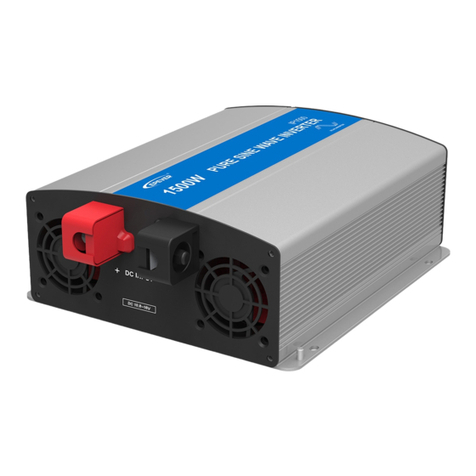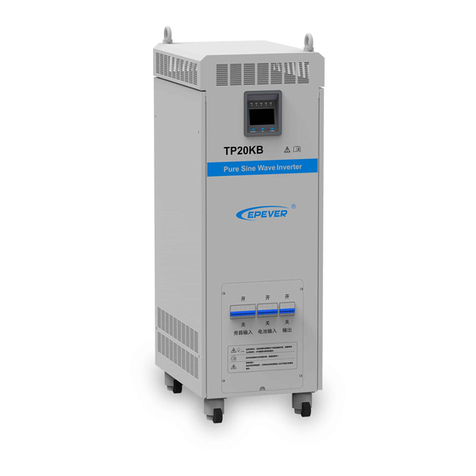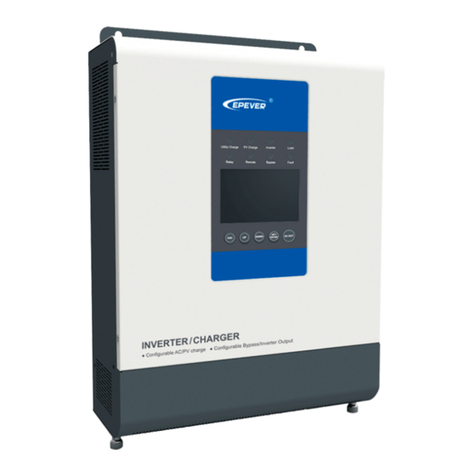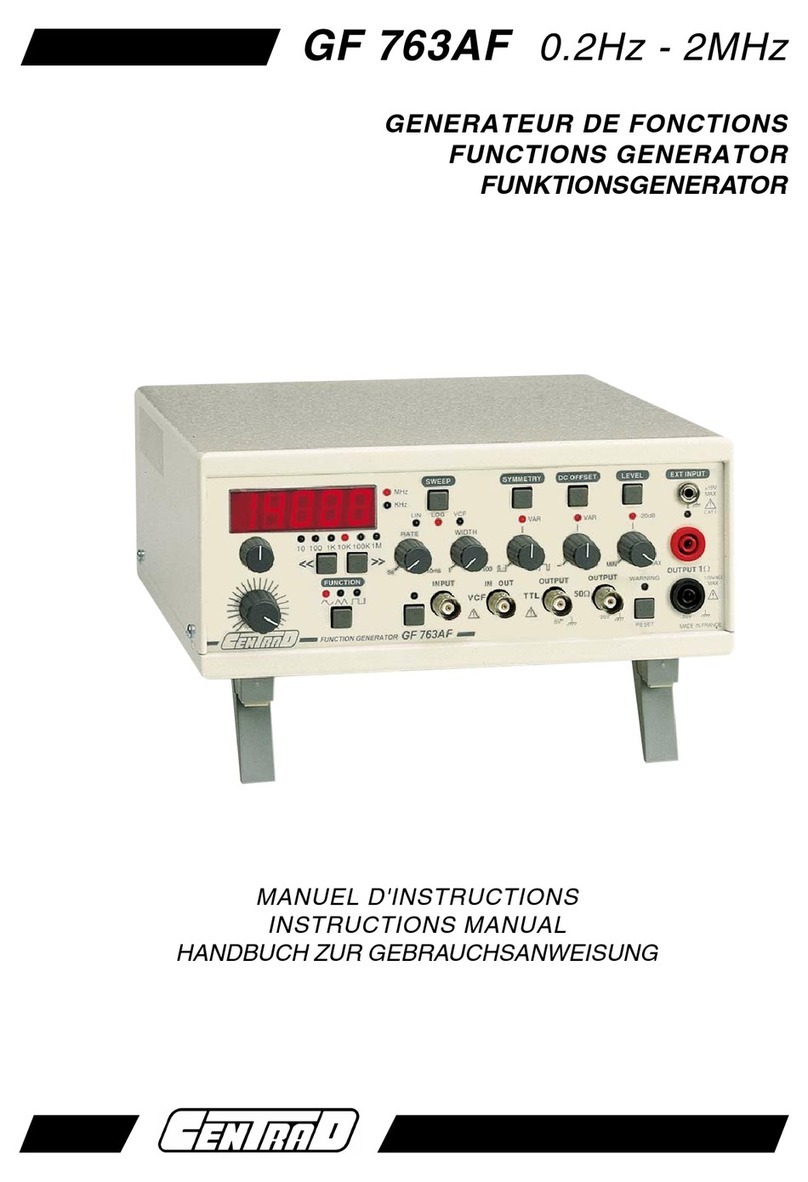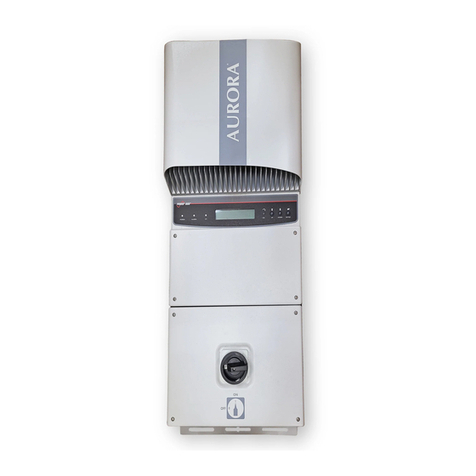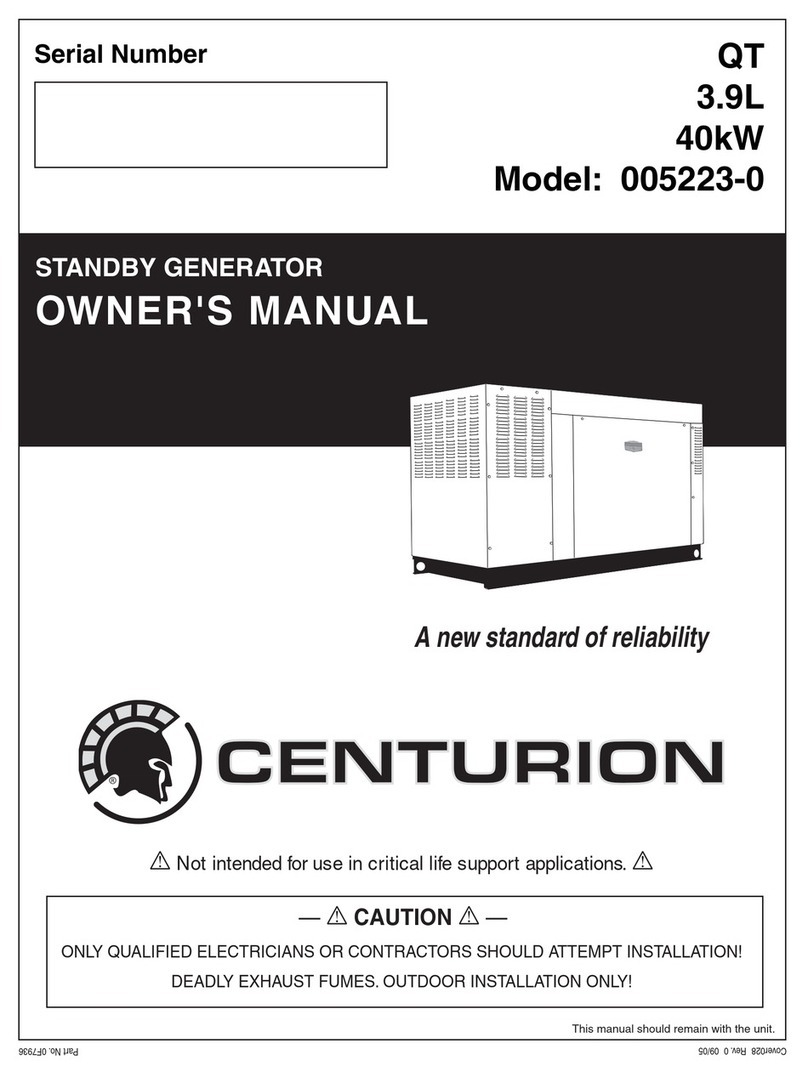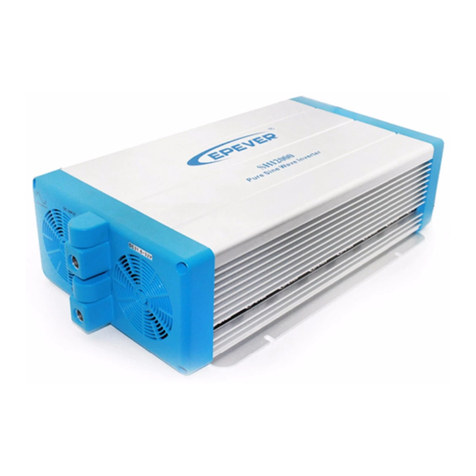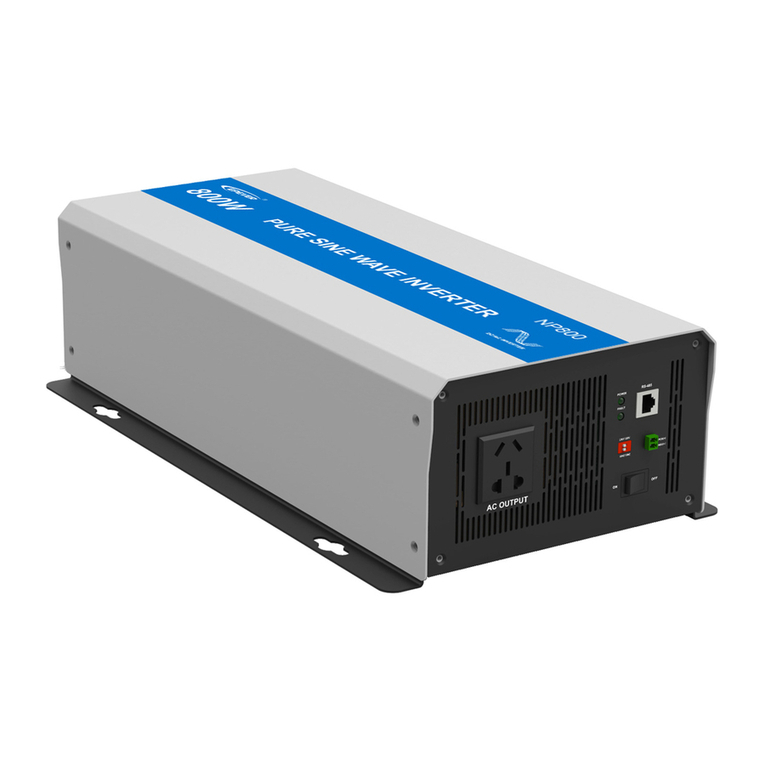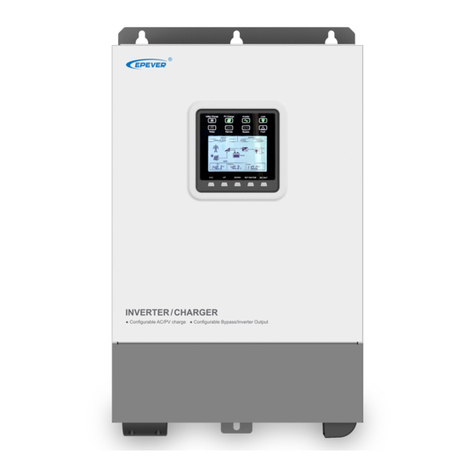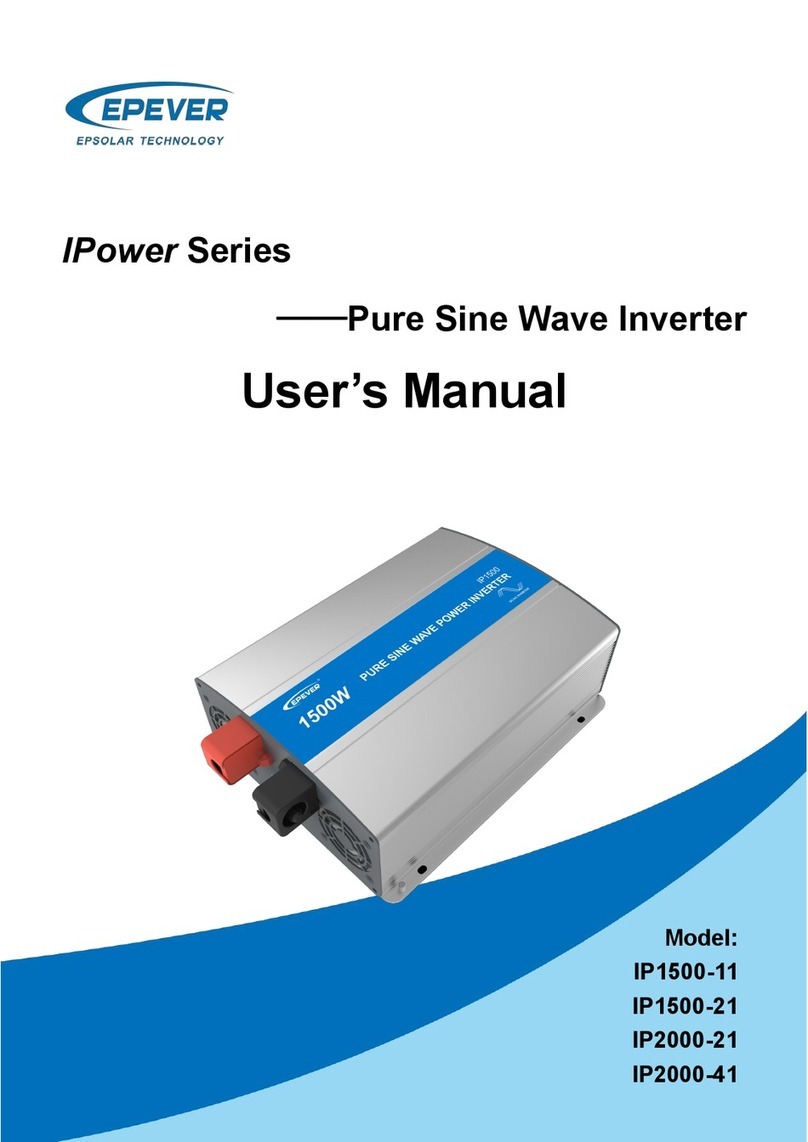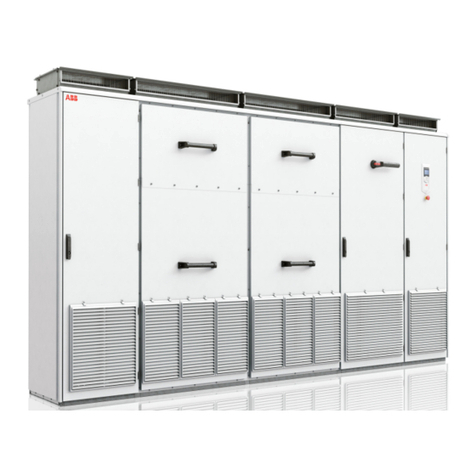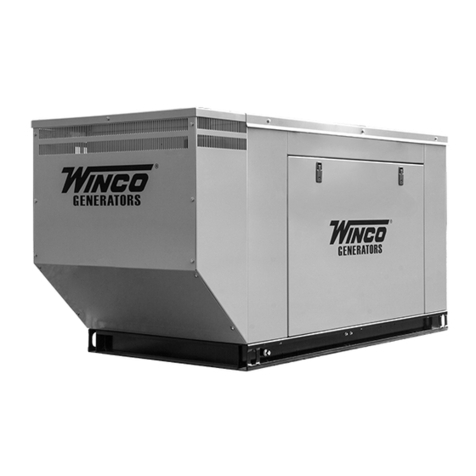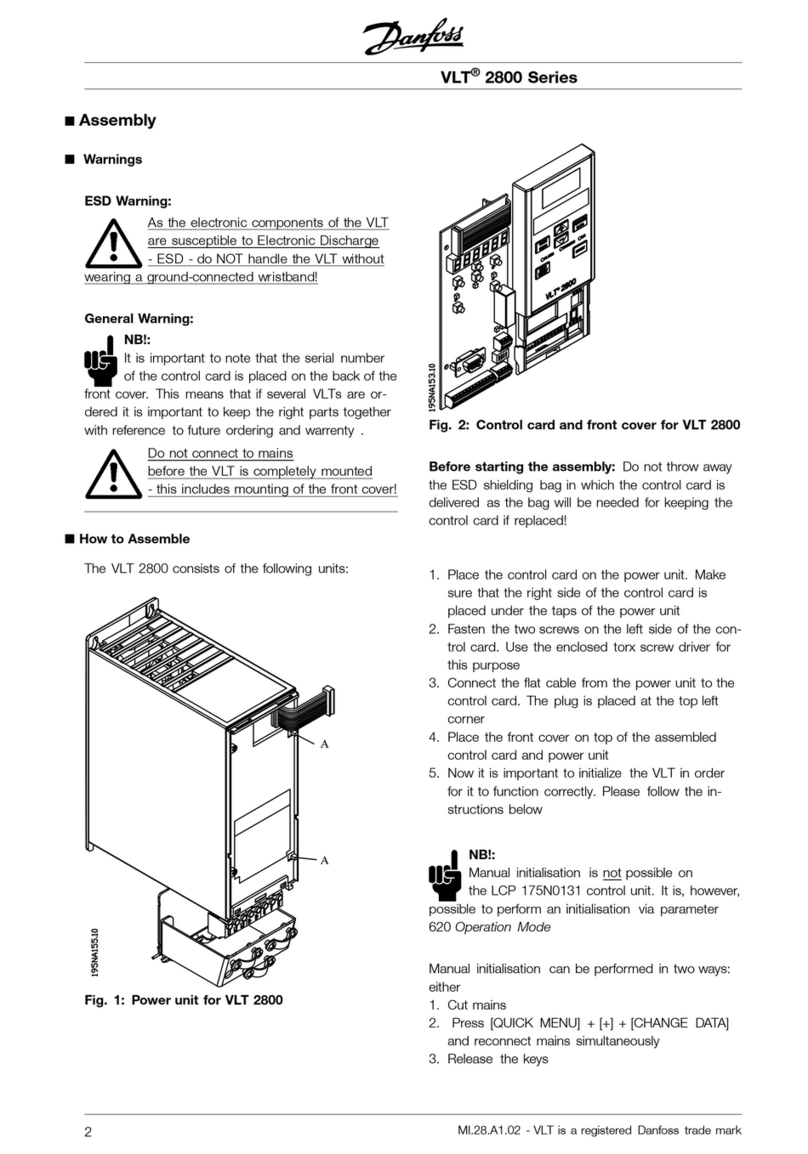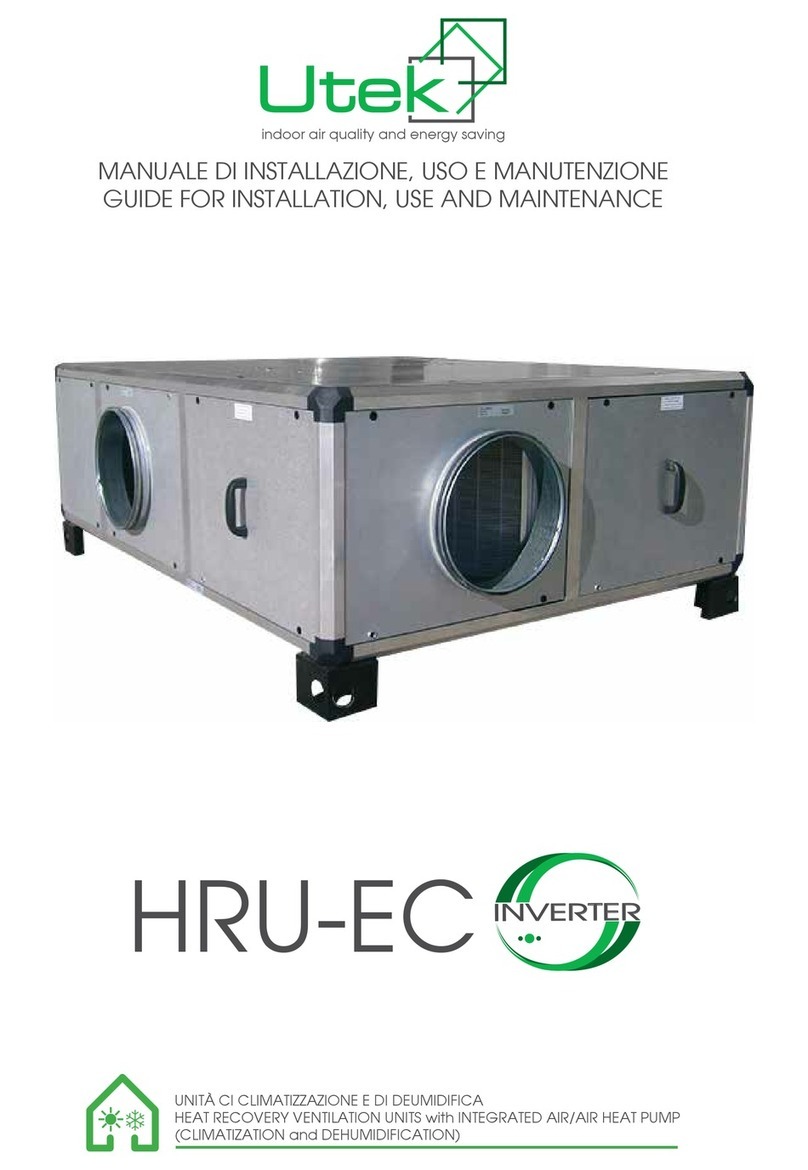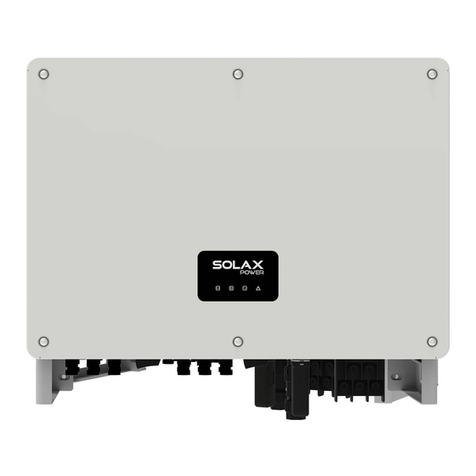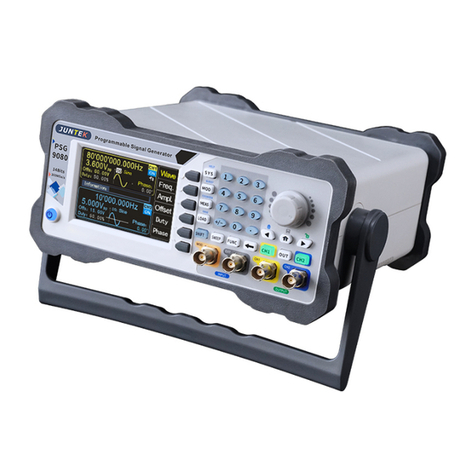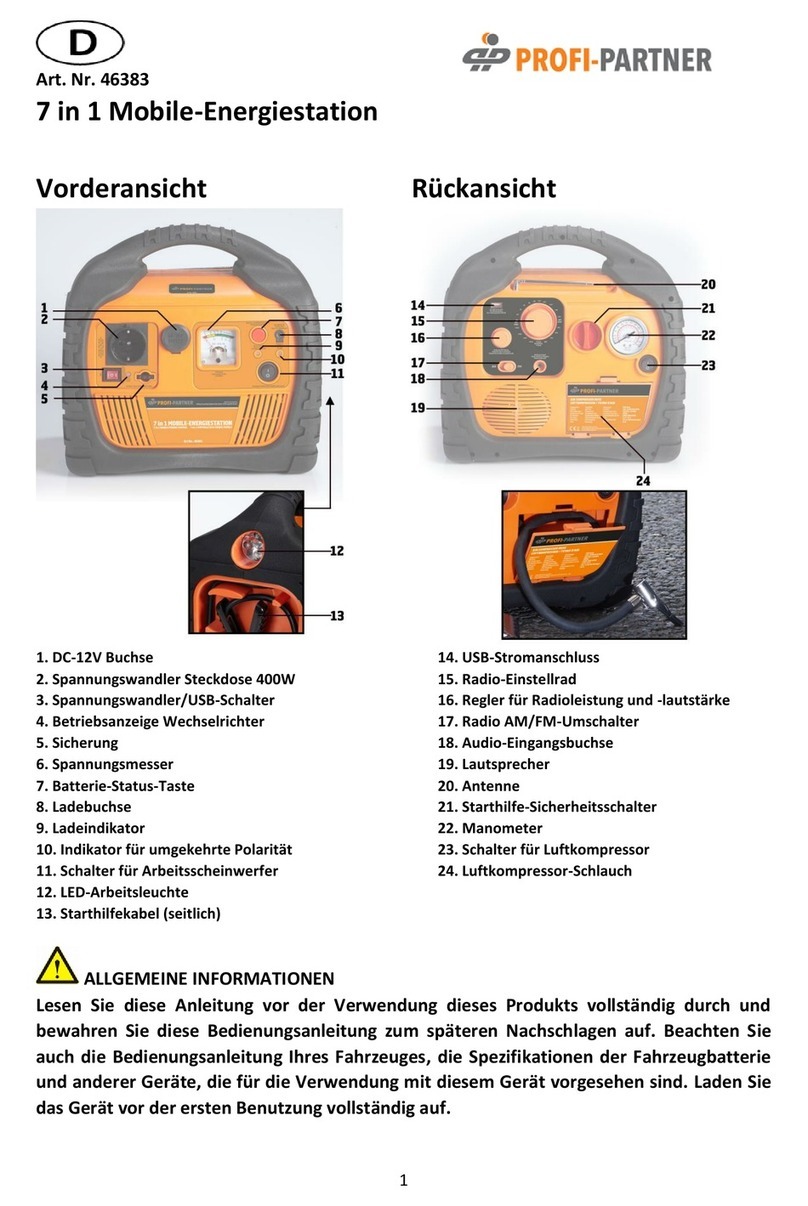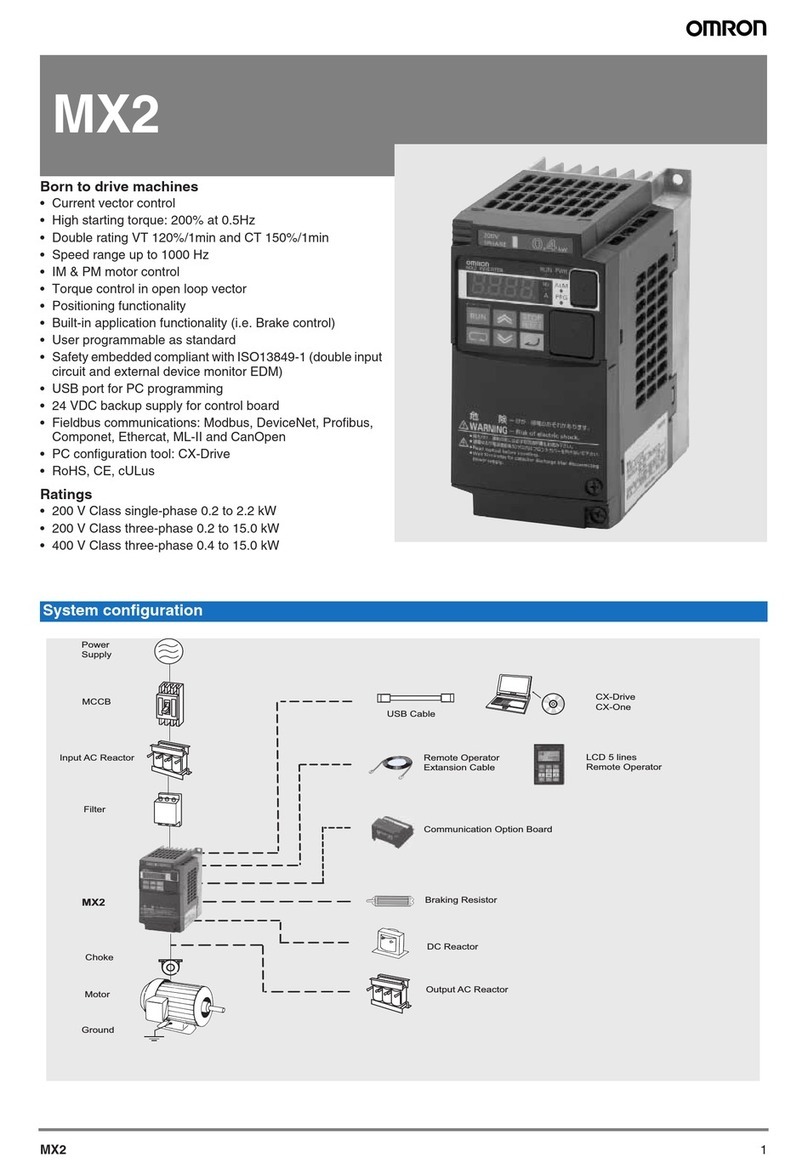
BEIJING EPSOLAR TECHNOLOGY CO., LTD. Tel:+86-10-82894112 / 82894962 Website:www.epsolarpv.com/www.epever.com
3 4
4) Real-time Control
Control the load ON/OFF time through setting real-time clock.
NOTE: In the mode of Light ON/OFF and Light ON/Timer, the Load is
turned on after 10Min. delay.
8. Protection
PV Reverse Polarity
Fully protection against PV reverse polarity, correct the wire connection to resume
normal operation.
WARNING: Controller will be damaged when the PV array straight
polarity and the actual operation power of the PV array is 1.5 times
greater than the rated charge power!
Battery Reverse Polarity
Fully protection against battery reverse polarity, correct the wire connection to
resume normal operation.
Battery Over Voltage
When the battery voltage reaches to the set point of Over Voltage Disconnect Voltage,
the controller will stop charging the battery to protect the battery from being over
charged to break down.
Battery Over Discharge
When the battery voltage reaches to the set point of Low Voltage Disconnect Voltage,
the controller will stop discharging the battery to protect the battery from being over
discharged to break down.
Battery Overheating
The controller detects the environment temperature through the external temperature
sensor. If the environment temperature exceeds 65 ºC, the controller will
automatically start the overheating protection to stop working, and recover below 55
ºC .
Load Short Circuit
Load will be switched off when load short circuit (≥4 times rated current) happens.
Controller will automatically attempt to reconnect load for 5 times. If short circuit
protection still exist after controller’s 5 times attempts, user have to clear short
circuit ,then restart the controller or wait for one night-day cycle (night time>3 hours).
Temperature sensor break down
If the temperature sensor short-circuited or damaged, the controller will be charging
or discharging at the default temperature 25 ºC to prevent the battery damaged from
overcharging or over discharged.
High Voltage Transients
The controller is protected against small high voltage transients. In lightning prone
areas, additional external suppression is recommended.
9. Troubleshooting
LED Charging indicator
turn off during daytime
when sunshine falls on
PV modules properly
Confirm that PV and
battery wire connections
are correct and tight
Battery voltage maybe
less than 9V
Measure battery voltage
with the multi-meter.
Min.9V can start up the
controller
Battery LED indicator
green fast Flashing
Check if battery voltage is
higher than OVD, and
Battery LED indicator
red
When the battery voltage
is restored to or above
LVR point (low voltage
reconnect voltage), the
load will recover
Battery LED indicator
red flashing
The controller will
automatically turn the
system off. But while the
temperature decline to be
below 50 ºC, the controller
will resume.
Charging(green) and
battery indicator
(orange)flashing
simultaneously
Check whether the battery
voltage match with the
controller’s working
voltage, If not please
change to a suitable
battery or reset the
working voltage
Powering on normally,
the load is off
①The connecting wires
are error or
virtually connected
②Load mode is not
appropriate.
③This controller does not
match with the LED light.
④Output short circuit.
①Check the connecting
cable.
②Check the load’s mode
and parameters.
③The voltage of LED light
is not within the output
voltage range of controller.
④Check the connecting
cables and LED light.
The dimming function is
invalid
The controller does not
match with the LED light
source. This product is a
step-up voltage control, If
input voltage is lower than
the rated voltage, it is not
working.
①Replace the LED light.
②Reduce system rated
voltage grade and replace
the product model.
For example 24V system
change to 12V system,
and replace the
corresponding controller
Infrared communication
error
Refer to handheld the user
device manual
①When the battery is over discharged, the battery indicator will be red and the load will be off all the
time before the voltage is more than the Low Voltage Reconnect Voltage (LVRV). In order to judge the
system is normal or not, firstly measuring the battery voltage whether is more than LVRV, if not,
restarting the controller to detect the load whether it is normal.
Note: The LVRV can be set, but it must pay more attention that it maybe damages the battery if
the LVRV is too low.
11. Disclaimer
This warranty does not apply under the following conditions:
Damage from improper use or use in an unsuitable environment.
PV or load current, voltage or power exceeding the rated value of controller.
The controller is working temperature exceed the limit working environment
temperature.
User disassembly or attempted repair the controller without permission.
The controller is damaged due to natural elements such as lighting.
The controller is damaged during transportation and shipment.
Any changes without prior notice! Version number:V3.1
10. Technical Specifications
Battery input voltage range
Max. PV open circuit voltage①
58V at minimum operating environment temperature
46V at 25℃environment temperature
95V at minimum operating environment temperature
92V at 25℃environment temperature
( Battery voltage+2V)~36V
( Battery voltage+2V)~72V
( Max. battery
voltage+2V)~46V
( Max. battery voltage+2V)~58V
( Max. battery voltage+2V)~80V
Load open circuit voltage
Maximum output efficiency
Output current control accuracy
Sealed(Default) / Gel / Flooded /User
Equalize Charging Voltage※
Sealed:14.6V / Gel:—/ Flooded:14.8V / User:9~17V
Sealed:14.4V / Gel:14.2V / Flooded:14.6V / User:9~17V
Sealed / Gel / Flooded:13.8V / User:9~17V
Low Voltage Reconnect Voltage※
Sealed / Gel / Flooded:12.6V / User:9~17V
Low Voltage Disconnect Voltage※
Sealed / Gel / Flooded:11.1V / User:9~17V
Temperature compensation
coefficient
Working environment
temperature
PV/BAT:14AWG(2.5mm2)
LOAD:18AWG(1.0mm2)
PV/BAT:12AWG(4mm2)
LOAD:16AWG(1.5mm2)
PV/BAT:14AWG(2.5mm2)
LOAD:18AWG(1.0mm2)
PV/BAT:12AWG(4mm2)
LOAD:16AWG(1.5mm2)
※Above parameters are in 12V system at 25 ºC, please double the values in 24V system.






